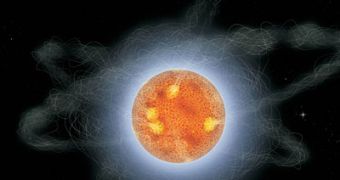Magnetars are a specific category of neutron stars that possess an unusually strong magnetic field. There aren’t many such celestial objects observed so far, although they could prove extremely interesting to scientists, since their powerful magnetism could have a strange impact on matter. Unfortunately, the modern technology of today is not yet able to recreate the kind of forces normally developed by a magnetar, which further limits our understanding of the object.
Neutron stars are the spinning, collapsed remains of the cores of former enormously massive dead stars (10 to 50 times the Sun's mass), which collapsed under their own weight. Their average current size is very small (with a diameter of around 20 km), but only a teaspoonful of their matter would weigh approximately a hundred million tons. Magnetars are a subtype of neutron stars that have an even more impressive magnetic field (around 1,000 times stronger than regular neutron stars), which transforms them into the universe's most potent magnets, with the power to bend their stellar crust.
Out of the approximately 15 magnetars discovered to date, five are known as soft gamma repeaters (SGRs), since they seldom release short (0.1 seconds) but large bursts of low-energy gamma rays and high-energy X-rays. The remaining ten or so are regarded as anomalous X-ray pulsars (AXPs). Since their magnetic fields cannot be reproduced in laboratory conditions, the only option left is direct observation. Thus, Dr. Nanda Rea and a team from the University of Amsterdam used XMM-Newton and Integral data.
The researchers managed to find real evidence of the impressive electron currents emitted by the magnetars as a result of their internal magnetic fields' activity and also to measure them, providing a crucial missing part of the puzzle. More clues that will ensure better comprehension of magnetars are expected to be obtained during future similar research projects.

 14 DAY TRIAL //
14 DAY TRIAL //